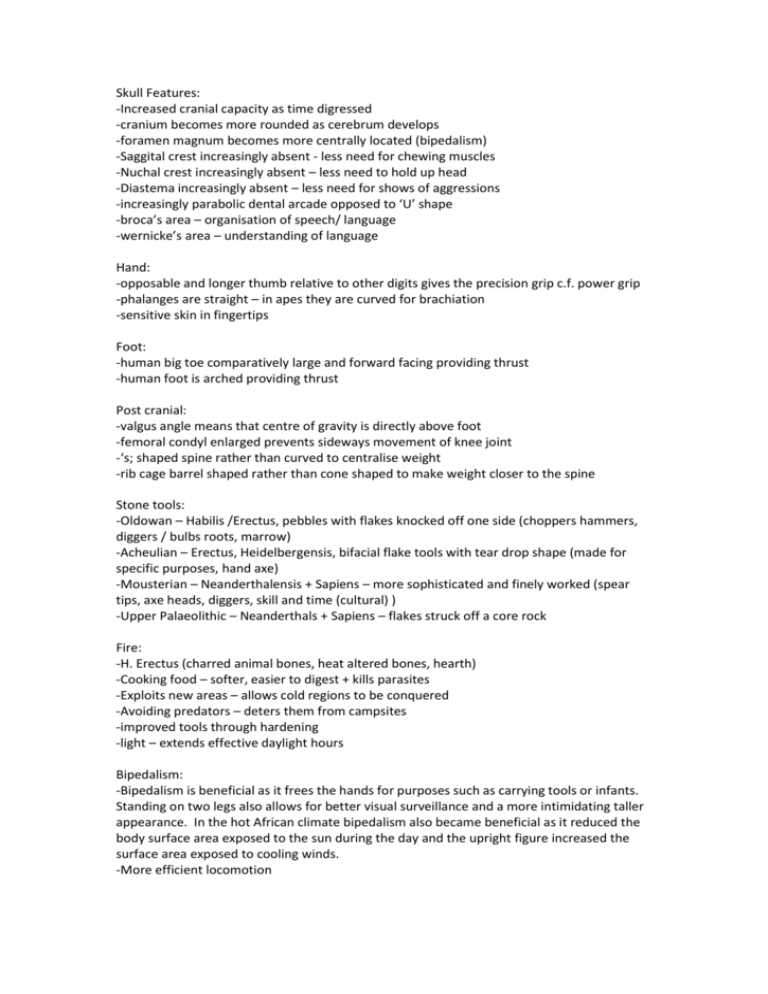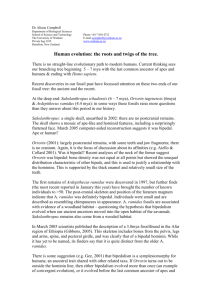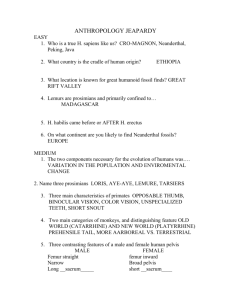3.7 Human Evolution - No Brain Too Small
advertisement

Skull Features: -Increased cranial capacity as time digressed -cranium becomes more rounded as cerebrum develops -foramen magnum becomes more centrally located (bipedalism) -Saggital crest increasingly absent - less need for chewing muscles -Nuchal crest increasingly absent – less need to hold up head -Diastema increasingly absent – less need for shows of aggressions -increasingly parabolic dental arcade opposed to ‘U’ shape -broca’s area – organisation of speech/ language -wernicke’s area – understanding of language Hand: -opposable and longer thumb relative to other digits gives the precision grip c.f. power grip -phalanges are straight – in apes they are curved for brachiation -sensitive skin in fingertips Foot: -human big toe comparatively large and forward facing providing thrust -human foot is arched providing thrust Post cranial: -valgus angle means that centre of gravity is directly above foot -femoral condyl enlarged prevents sideways movement of knee joint -‘s; shaped spine rather than curved to centralise weight -rib cage barrel shaped rather than cone shaped to make weight closer to the spine Stone tools: -Oldowan – Habilis /Erectus, pebbles with flakes knocked off one side (choppers hammers, diggers / bulbs roots, marrow) -Acheulian – Erectus, Heidelbergensis, bifacial flake tools with tear drop shape (made for specific purposes, hand axe) -Mousterian – Neanderthalensis + Sapiens – more sophisticated and finely worked (spear tips, axe heads, diggers, skill and time (cultural) ) -Upper Palaeolithic – Neanderthals + Sapiens – flakes struck off a core rock Fire: -H. Erectus (charred animal bones, heat altered bones, hearth) -Cooking food – softer, easier to digest + kills parasites -Exploits new areas – allows cold regions to be conquered -Avoiding predators – deters them from campsites -improved tools through hardening -light – extends effective daylight hours Bipedalism: -Bipedalism is beneficial as it frees the hands for purposes such as carrying tools or infants. Standing on two legs also allows for better visual surveillance and a more intimidating taller appearance. In the hot African climate bipedalism also became beneficial as it reduced the body surface area exposed to the sun during the day and the upright figure increased the surface area exposed to cooling winds. -More efficient locomotion -African drought decreased forest sizes, so it was advantageous to be mobile due to the increased competition in forests. Multiregional: -H. Ergaster left Africa 1-2mya – dispersed throughout the world, some degree of gene flow remained – genetic drift and natural selection produced races, but all evolved into H. Sapiens. Out of Africa: -H. Ergaster left Africa 1-2mya – different populations became geographically and reproductively isolated, evolving into variants through the old world. -Modern humans evolved in Africa from Erectus then 160,000 years ago migrated out of Africa replacing the existing erectus populations with minimum interbreeding -Mitochondrial DNA evidence shows more variation in Africa than in the rest of the world – indicating that the rest of the world all came from a common ancestor who left Africa. -Multiregional is argues by fossil evidence showing transitional forms (subject to interpretation) -Multiregional proponents suggest the current morphological differences in humans in infeasible in the time from OOA suggests. -Molecular evidence is undeniable and shows a high degree of homogeneity. Biological vs Cultural Evolution: Biological: -All species involved -origin of change (cause of evolution) is random changes in DNA in gamteic cell line, passed onto offspring. -information is passed on at fertilisation in a single moment of transmission, subject to change via mutation -only passed from parent to offspring -slow, genetically based, passed on and acted upon by natural selection -random Cultural: -mostly only humans involved -innovations in technology, behaviour, social structure that are worth retaining and passing on are causes of cultural evolution -information passed on via oral communication, modelling, art, language -occurs through a lifetime -parent > offspring as well as offspring > parent -any individual > and individual -rapid cumulative process which builds on previous knowledge -purposeful











